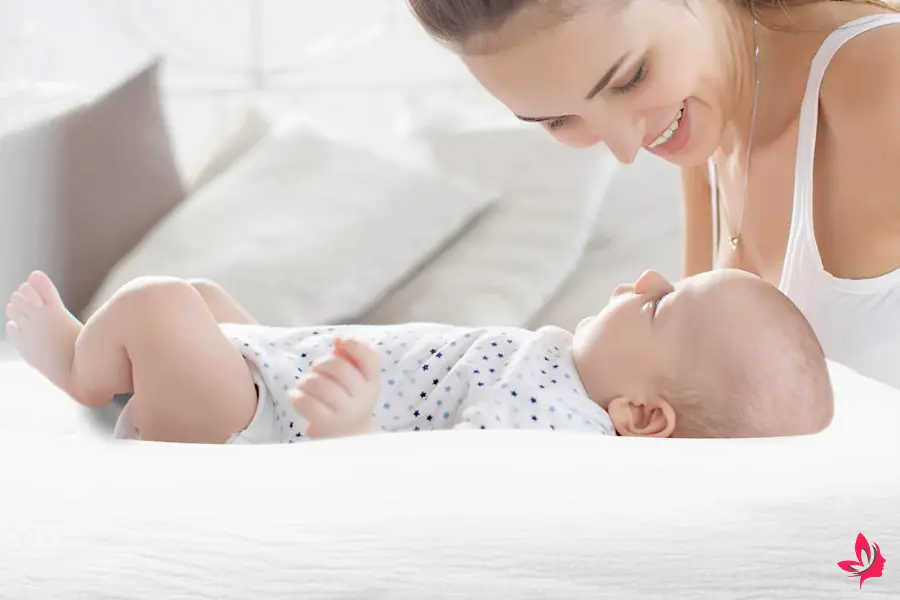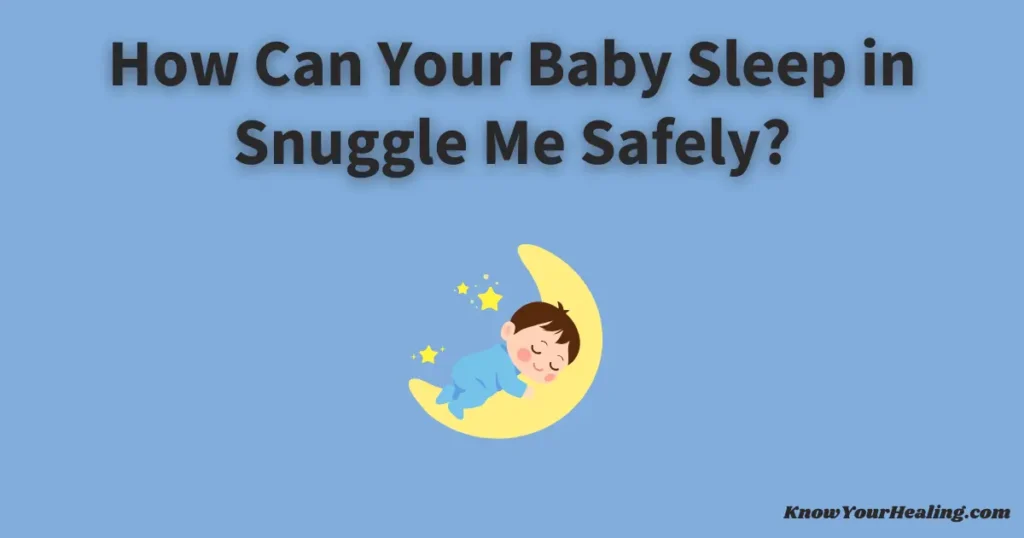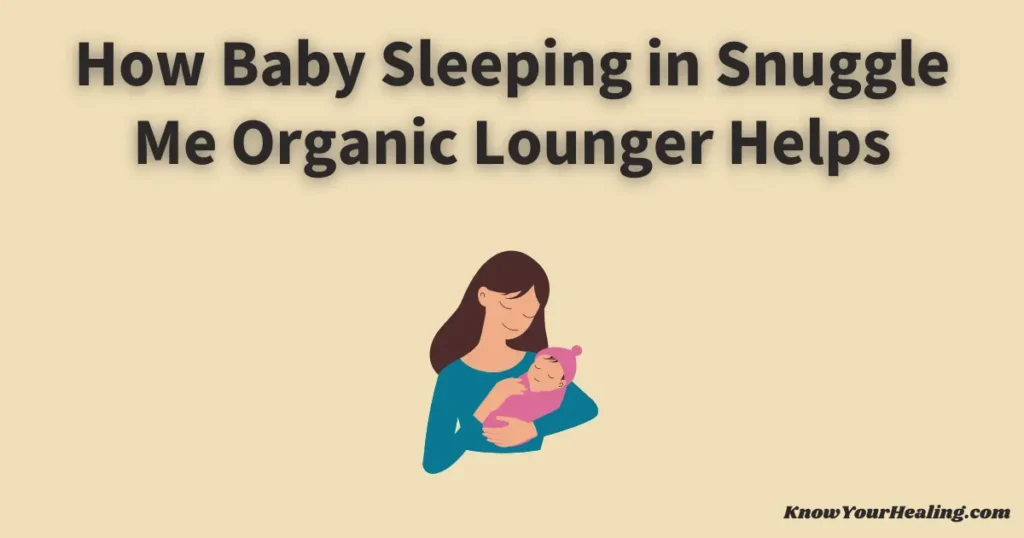Can a baby sleep in Snuggle Me? Many parents wonder about this, hoping for a cozy and convenient spot for their children to take naps.
Babies should not sleep in a Snuggle Me lounger because it is not designed for safe sleep and may increase the risk of suffocation or positional asphyxia.
Families want answers that help protect their little ones and create peace of mind. This article provides current guidance, clears up confusion, and explains exactly how to use a Snuggle Me safely if you choose to do so.
Understanding Can a Baby Sleep in Snuggle Me: Safety Basics
Many new parents ask if a baby can sleep in Snuggle Me loungers, especially when searching for a cozy space for their child. The basics of infant sleep safety and expert recommendations are crucial for making informed decisions about a baby’s sleep environment.
What Is a Snuggle Me Organic Infant Lounger?
A Snuggle Me Organic infant lounger is a padded, oval-shaped cushion made to hug a baby’s body snugly. It is made from organic cotton and filled with polyester fiber to give a gentle touch to a newborn’s sensitive skin.
The product promotes a sense of security and is often described as an “extra set of arms” for new parents. Parents use this lounger for supervised lounging, tummy time, and calming a fussy infant.
It comes in sizes for infants 0-9 months, with a larger toddler lounger for older babies. The Snuggle Me Organic lounger is portable and fits various lifestyles, whether at home or visiting relatives.
The entire lounger is usually machine washable using a cold, gentle cycle with mild or free detergents, making it easy to care for.
Why Snuggle Me Lounger Is Not a Safe Sleep Device
A Snuggle Me lounger is not a safe sleep device for babies. The brand states that its products are not intended for sleep, including supervised naps and nighttime rest.
Using a baby lounger for sleep increases the risk of threats to a baby’s safety. Babies can roll, turn, or slide in the lounger, causing their heads to move into padded sides or soft surfaces.
These design features increase the risk of accidental suffocation. Risks are especially high for infants who are not yet strong crawlers or who have limited control over their positioning.
The Role of the American Academy of Pediatrics in Baby Safety
The American Academy of Pediatrics (AAP) provides clear guidelines for safe infant sleep. The AAP advises that babies should always sleep on a flat surface, like a firm crib or bassinet mattress, with only a fitted sheet.
The lounger does not meet these safety standards. Research by the AAP found that products like baby loungers, bouncers, and swings contribute to incidents of baby death when used for sleep, regardless of whether an alert adult is present.
The risk of SIDS, sudden infant death, rises with the use of soft, padded sleeping devices. The AAP recommends following safe sleep practices and never placing a baby to sleep on uneven surfaces, soft bedding, or inside a lounger.
Importance of a Flat Surface and a Firm Mattress for Baby Sleep
Safe places for a baby to sleep require a flat surface and a firm mattress, such as those found in a crib or bassinet. This setup supports the baby’s body evenly and keeps the baby’s head and airway clear.
Uneven blankets, pillows, or the padded sides of a lounger can change the baby’s position, raising the risk of suffocation or breathing problems.
Following safe crib practices means putting the baby to sleep only in their crib or bed, never in a lounger, on a couch, or beside soft objects.
Only a fitted sheet should be in the crib, with no loose bedding or additional padding.
Avoiding Harmful Chemicals and Flame Retardants in Baby Loungers
When choosing any product for a baby, such as a Snuggle Me Organic lounger, parents should look out for the materials used. Products made from organic cotton or gentle dye are less likely to contain flame retardants or harmful chemicals that could irritate sensitive skin.
Producing an organic lounger without flame retardants and using machines with mild, free detergents reduces exposure to toxins. These materials are safer for a baby’s delicate body.
Always check product labels and details before purchasing to ensure the item supports your family’s health and your baby’s safety.
Best Practices for Safe Sleep When Using Snuggle Me Lounger

Baby sleep safety depends on the right setup and careful supervision. A snug place like the infant lounger brings comfort, but only when following recommended guidelines to prevent the risk of SIDS, suffocation, or injury.
Always Use Snuggle Me Lounger with an Alert Adult Present
A baby should always use a Snuggle Me Lounger with an alert adult present. The lounger is not a safe sleep device, and babies should never be left to sleep unsupervised in one, even for a short time.
According to the American Academy of Pediatrics, many infant sleep deaths occur in non-sleep products like bouncers and baby loungers, even when parents are nearby but not closely monitoring the child.
Avoid treating the baby lounger as a substitute for a crib or bassinet. Babies should use the Snuggle Me Organic lounger only for awake time or when adults can pay close attention.
Ensuring Baby’s Body Positioning and Own Position in Lounger
Proper positioning of the baby’s body is critical for safety. The baby’s head should always rest near the top of the lounger, with shoulders touching the surface and legs pointed toward the bottom end of the lounger.
The padded sides should never block the baby’s airway or cover the baby’s face. Never place a blanket, pillow, or extra padding under or around the baby, as these can cause suffocation or increase the risk of SIDS.
Babies should be placed on their backs—never on their stomachs or sides—in line with safe sleep guidelines. Proper positioning helps prevent rolling or shifting deeper into the lounger.
Why Uneven Surfaces and Blankets Increase the Risk of SIDS
Placing a Snuggle Me Lounger on an uneven surface, such as a sofa, bed, or cushioned chair, creates a hazardous environment. Uneven surfaces and loose bedding, such as blankets, increase the risk of SIDS by making it easier for a baby to roll into a dangerous position, fall, or have their face pressed against padded sides or fabric.
The safest place for the lounger is on a firm ground surface, never on elevated spots or near edges. Babies should sleep without loose bedding, pillows, or toys, as these items pose suffocation risks.
Safe Sleep Environment: From Own Crib to Safe Sleep Space
The safest place for a baby to sleep is a flat, firm mattress in the baby’s crib, without loose items or blankets. The Snuggle Me Lounger is not designed or recommended as a sleeping device for naps or overnight sleep.
Instead, use the lounger for supervised awake time, such as tummy time or a cozy, safe spot for lounging. Cribs with only a fitted sheet create the ideal safe sleep environment, reducing the risk of products not approved for sleep.
Toddler Lounger vs Infant Lounger: Age and Safety Guidelines
Understanding the difference between a toddler lounger and an infant lounger is vital for a baby’s safety. The infant lounger is designed for babies 0-9 months who have not yet begun rolling or crawling.
Once a baby becomes a strong crawler or can roll over, they should transition to the toddler lounger for supervised lounging only, not for sleep. Each lounger is crafted from organic materials, including organic cotton filled with polyester fiber, and is free from flame retardants and other harmful chemicals.
Always follow guidelines such as washing on a cold, gentle cycle with gentle dye-free detergents, especially for sensitive skin. Safety guidelines recommend never using a toddler or infant lounger as a sleep device or as a substitute for a crib or safe sleep space.
Care and Maintenance Tips for Your Snuggle Me Organic Lounger
Snuggle Me Organic loungers require thoughtful care and regular cleaning for baby’s safety. Cleaning methods, fabric quality, and safe handling are crucial in ensuring every baby lounger creates a safe sleep environment for infants and young children.
Washing Your Snuggle Me Lounger: Cold Gentle Cycle and Mild Detergent
Clean the Snuggle Me lounger using a cold, gentle cycle in the washing machine. This protects the organic cotton fabric and preserves its softness for the baby’s delicate skin.
Use a mild detergent that is free from harsh chemicals, strong scents, and artificial dyes. This reduces the risk of skin irritation or allergies for newborns and older babies.
Spot clean small messes as soon as possible, especially if the Snuggle Me is used during feedings or tummy time. Air dry the lounger if possible, or tumble dry on the lowest heat setting to avoid shrinking or damaging the fabric.
Avoid overloading the washer. Washing the entire lounger separately helps maintain the unique structure and prevents uneven wear.
Benefits of Organic Cotton and Gentle Dye in Baby Loungers
Choosing a baby lounger made with organic cotton is a great idea. Organic materials are gentle, breathable, and do not contain harmful chemicals, flame retardants, or synthetic pesticides.
This is especially important for the sensitive skin of newborns. The Snuggle Me Organic lounger uses gentle dye processes, helping prevent contact with harsh substances.
Using organic cotton improves airflow around the baby’s body and enhances the firmness of the lounger. All these factors help create a cozy space for multi-functional lounging, with safety as a top priority.
Machine Washable Products and Using Free Detergents for Baby Safety
Many parents wonder if their product is machine washable. The Snuggle Me lounger and covers are designed to be washed in most home washing machines, including top-loaders.
This provides parents with an easy way to keep the infant lounger clean and free from germs. Using free detergents (those without brighteners, dyes, and perfumes) helps prevent residue buildup.
These detergents are safer for a baby’s sensitive skin. They also help keep the lounger in good condition after each wash.
After washing, ensure the product is dehydrated before allowing a baby to use it again. Moisture can cause mold, which is unsafe for babies.
Handling the Entire Lounger and Tracking Link for US Shipping
When moving or cleaning the lounger, lift and support the entire lounger. Avoid grabbing just one side or the padded ends.
This protects its structure and keeps the sides firm and supportive for the baby. For families in the United States or Puerto Rico, you will receive tracking link updates with each order.
This helps you keep track of deliveries and the package’s size. Shipments to P.O. boxes may have special handling times and shipping practices.
Always place the Snuggle Me on a firm, flat surface, such as a floor or crib mattress. This provides extra protection and proper support.
Safety Don’ts: Avoid Loose Bedding, Seat Belts, and Unsupervised Sleep
Parents should remember important safety tips when using a baby lounger. Do not add loose bedding, uneven blankets, or pillows to the lounger.
These items can increase the risk of SIDS by covering the baby’s head and face. Never use the Snuggle Me as a sleeping device at night or during unsupervised sleep.
The safest place for a baby to sleep is always a firm mattress in their crib, following safe sleep guidelines from the American Academy of Pediatrics.
Do not use seat belts or straps to fasten the baby. Never place the lounger on uneven surfaces, couches, or soft beds.
The Snuggle Me lounger is meant for supervised awake time only. Do not use it for night sleep or as a permanent resting place.
Frequently Asked Questions
The Snuggle Me lounger is for supervised use only, not for overnight or unsupervised sleep. Infant sleep safety guidelines recommend using flat and firm sleep surfaces without soft bedding or toys.
Why can’t the baby sleep in Snuggle Me?
Babies should not sleep in the Snuggle Me because it is not a safe sleep surface. The lounger’s soft sides and padding can lead to suffocation risk if a baby rolls over or presses their face against the material.
At what age can a baby sleep with a cuddly toy?
Babies should not sleep with soft toys, stuffed animals, or loveys in the crib until after their first birthday. Introducing a cuddly toy too early increases the risk of suffocation and Sudden Infant Death Syndrome (SIDS).
Pediatricians recommend only using a fitted sheet in the crib until your baby is at least 12 months old.
Can I let my baby sleep in a lounger?
Babies should not sleep in any type of lounger. Loungers, including Snuggle Me and similar products, are not approved for use as infant sleep devices.
Can my baby sleep in a snuggle nest?
Snuggle nests are not safe sleep spaces for infants. Like loungers, these products may have soft sides or padding that can cause suffocation if a baby rolls or turns their face into the material.
Flat, firm crib mattresses are recommended instead.
How should a baby lie in Snuggle Me?
If you use the Snuggle Me while your baby is awake and supervised, place the baby on their back. Keep the lounger on flat, firm surfaces, and never leave a baby unattended.
Do not let your baby sleep in the lounger.
What to do if a newborn rolls on the side while sleeping?
If a newborn rolls to their side while sleeping, gently move them onto their back. Back sleeping is the safest position for infants.
Always ensure the sleep surface is firm and free from soft items.
Is it bad to cuddle your baby to sleep?
Cuddling a baby to help them fall asleep is not dangerous, as long as you move the baby to a safe, flat sleep space after they fall asleep. Parents should not fall asleep while holding their baby in chairs, sofas, or beds, as these places can increase the risk of accidental injury.
Is Dock a tot or Snuggle Me better?
Neither the DockATot nor the Snuggle Me is approved for unsupervised infant sleep. Both are meant for lounging while the baby is awake and supervised.
There is no evidence that one is safer for sleep than the other. Always use these products as instructed.
Is Baby Snuggle safe for newborns?
Snuggle Me can be used for newborns only when they are supervised and awake. It is not approved or marketed as a safe sleep solution for newborns or older infants.
Babies should always be moved to a crib or bassinet for sleep.
What is rebreathing a baby?
Rebreathing occurs when a baby inhales its own exhaled air.
This can occur if a baby’s face is too close to soft bedding or padding. The build-up of carbon dioxide can happen in these situations.
This is one reason why experts do not recommend soft loungers, blankets, and toys in cribs or sleep spaces.


